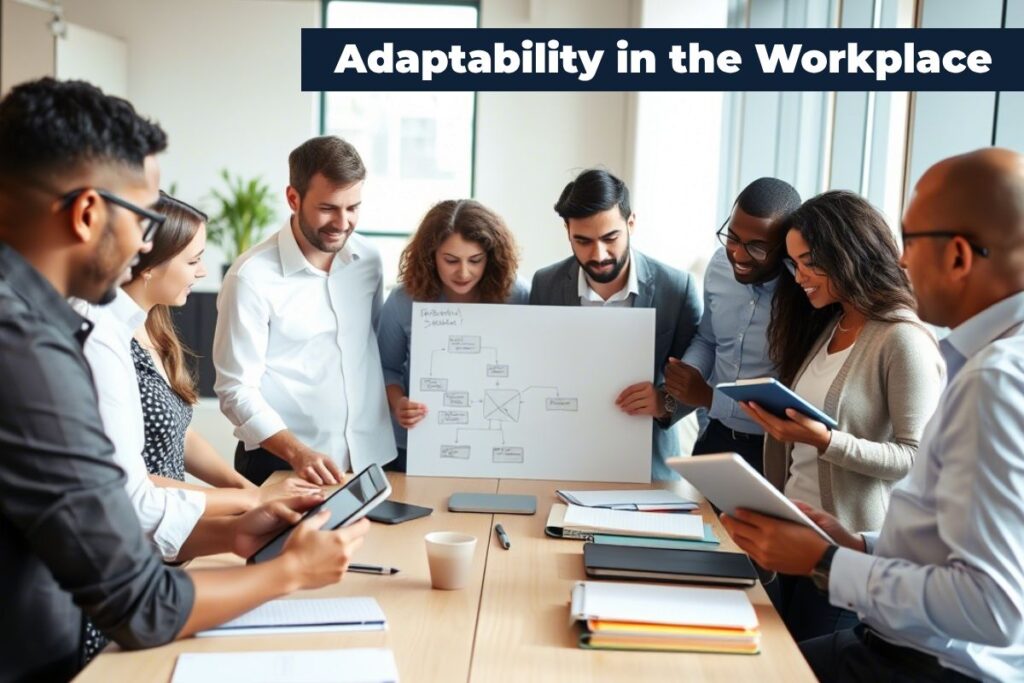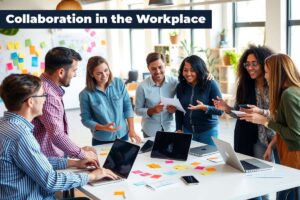
Adaptability in the Workplace
Adaptability in the workplace is more than just a skill—it’s a necessity for professional growth and business success.
As the world evolves, so do our lives, environments, and workplaces.
Our careers are increasingly influenced by new technologies designed to improve efficiency and customer service.
Change is constant, whether in industries, business needs, or customer preferences.
With new managers and employees bringing fresh ideas, staying adaptable is essential to overcoming challenges and thriving in a changing work environment.
Organizations must evolve to stay competitive, and employees must be flexible enough to adjust to these shifts.
While some people resist change, those who embrace adaptability position themselves as valuable assets to their companies.
What is Adaptability in the Workplace
Adaptability is the ability to adjust to changes in your surroundings.
Adaptability in the Workplace refers to an individual’s or organization’s ability to adjust effectively to changing circumstances, challenges, or demands.
It involves staying flexible, open-minded, and proactive in the face of evolving priorities, technologies, or environments.
As you plan your career, it’s important to recognize how workplace changes impact your ability to stay flexible.
Being adaptable means responding quickly and effectively to new situations. For example, a new manager or team member may introduce different work methods.
Keeping an open mind and sharing your own ideas helps create a smooth transition.
Similarly, when new systems or technologies are implemented, job roles may shift.
Being willing to learn and adjust ensures tasks are completed efficiently while meeting company policies and industry standards.
Why Adaptability Matters in The Workplace and Business
Work priorities can shift to meet business needs, leading to changes in expectations.
Strategies may need to evolve in response to unexpected situations, such as a global crisis.
During the COVID-19 pandemic, many employees had to adjust to remote work, using platforms like Zoom and Microsoft Teams for communication.
In-person training was replaced with online learning, requiring a new approach to skill development.
Businesses must continually evolve to survive. Several factors drive change in the workplace, including technological advancements, market competition, and evolving customer needs.
1. Technological Advancements
Technology is rapidly transforming industries. Employees must learn new tools, software, and processes to remain efficient and relevant.
For instance, if a company transitions from Microsoft Word to Excel for financial tracking, employees should seek training to master the new system.
2. Market Competition
Companies constantly refine their strategies to stay ahead of competitors.
To remain competitive, employees must understand market trends and develop new skills that align with business needs.
3. Changing Customer Needs
Customer expectations shift due to market trends, economic conditions, and lifestyle changes.
For example, the widespread shift to remote work has altered how businesses interact with customers.
Employees who can adapt to changing customer needs contribute significantly to business success.
Understanding why these changes happen helps professionals develop the right mindset to stay ahead.
As businesses focus on improving efficiency and customer service, workplace processes will continue to change.
Staying adaptable allows you to keep up with these transformations, embrace new methods, and position yourself for long-term success.
How to Build Adaptability in the Workplace
In today’s fast-changing work environment, adaptability is a must-have skill.
While adjusting to change can be challenging, learning to adapt improves performance and makes you a driving force for positive growth in your organization.
Here are some practical ways to develop adaptability in the workplace and thrive in any situation.
Take on New Challenges
One of the best ways to become more adaptable is to step outside your comfort zone.
Taking on new projects and responsibilities helps you learn, grow, and become more flexible in handling different tasks.
Even if you’re unfamiliar with a certain area, trying new things allows you to gain experience and expand your skill set.
The more you expose yourself to different roles and challenges, the more valuable you become to your organization.
Set Small, Manageable Goals
Big changes can feel overwhelming, but breaking them down into small steps makes them easier to handle.
Set clear, achievable goals that align with your company’s objectives.
Track your progress and celebrate small victories along the way. These successes build confidence and reinforce the idea that adaptability in the workplace is a continuous journey of growth.
Build Confidence Through Learning
Confidence makes it easier to handle change. By continuously learning and embracing new experiences, you develop a mindset that welcomes challenges.
Reflect on your achievements and recognize areas where you can improve.
This self-awareness helps you build resilience, making it easier to face unexpected changes with a positive attitude.
Stay Positive and Keep Calm
A calm and positive mindset is essential when dealing with change.
Stress and negative emotions can cloud judgment and make it harder to adapt.
Practicing mindfulness, meditation, or other relaxation techniques can help you stay focused and clear-headed.
When you approach challenges with confidence and optimism, you not only handle change better but also inspire those around you to do the same.
Support Your Team
Adaptability isn’t just about personal growth—it’s also about creating a supportive environment.
Help your colleagues adjust to change by sharing your experiences and working together to find solutions.
Open communication and teamwork make transitions smoother for everyone.
By fostering a culture of collaboration, you strengthen your team and make it easier for everyone to embrace change.
Keep Learning and Expanding Your Skills
A constantly evolving workplace requires continuous learning. Take advantage of training programs, online courses, and workshops to stay updated with industry trends.
Whether you’re learning new software, improving communication skills, or developing leadership abilities, ongoing education prepares you for future challenges.
The more you invest in your growth, the more adaptable and valuable you become.
By developing these habits, you can confidently navigate change, support your team, and position yourself for long-term success. Adaptability isn’t just about survival—it’s about thriving in any situation.
Best Practices for Adaptability in the Workplace
Adaptability in the workplace is essential for both employees and organizations to thrive in a constantly changing environment.
By adopting key strategies, professionals can enhance their flexibility, remain valuable contributors, and help create a resilient workplace culture.
Commit to Continuous Learning
To stay relevant, employees must embrace lifelong learning. Keeping up with industry trends, new technologies, and evolving best practices ensures professionals can navigate changes effectively.
Engaging in workshops, online courses, or industry events helps expand knowledge and develop critical skills.
A mindset of continuous learning not only strengthens individual expertise but also positions employees to seize new opportunities.
Let Go of Outdated Methods
Adaptability in the workplace requires a willingness to unlearn old habits that no longer align with business goals.
Holding onto outdated methods can hinder growth and innovation.
By staying open to new approaches, employees can adopt fresh strategies that drive success.
Flexibility in thinking and problem-solving allows individuals and organizations to evolve and remain competitive.
Take Initiative
Proactive employees stand out in an adaptable workplace. Volunteering for new projects, stepping outside one’s comfort zone, and seeking collaboration opportunities demonstrate a commitment to growth.
Engaging in unfamiliar tasks helps build confidence, expand skill sets, and showcase adaptability to leadership.
Taking initiative fosters innovation and reinforces a culture of responsiveness.
Align with Company Goals
Understanding and supporting the organization’s mission ensures employees contribute meaningfully.
Staying informed about company objectives helps professionals prioritize their efforts and adapt to changing priorities.
When employees align their work with business goals, they become strategic contributors who drive success even in uncertain times.
Promote a Culture of Adaptability
A workplace thrives when adaptability is embraced at all levels. Encouraging open communication, collaboration, and shared learning fosters a supportive environment where change is seen as an opportunity.
Recognizing and celebrating adaptability in colleagues strengthens resilience across teams.
When employees feel empowered to evolve, organizations become more agile and better equipped to handle challenges.
By practicing these adaptability strategies, employees can enhance their professional growth, strengthen their organizations, and create a work environment that embraces change with confidence.
Final Thoughts on Workplace Adaptability
Adaptability in the workplace is a crucial skill that benefits both employees and organizations.
By staying open to new experiences, continuously learning, and supporting others, professionals can navigate workplace changes with confidence.
Embracing adaptability not only enhances career growth but also contributes to the long-term success of businesses in a rapidly evolving world.
By adopting these strategies, you can transform workplace challenges into opportunities and position yourself as a leader in an ever-changing professional landscape.
Adaptability is a cornerstone of professional success in today’s ever-evolving workplaces. By demonstrating this skill, you position yourself as a forward-thinking, resilient candidate or leader.
Top Frequent Asked Questions:
QUESTION: What exactly is adaptability in the workplace?
ANSWER: Adaptability in the workplace refers to an employee’s ability to adjust to changes in their work environment, tasks, responsibilities, or organizational structure. It involves being flexible, open to new ideas, and able to learn and apply new skills as needed.
QUESTION: Why is adaptability so important in today’s workplace?
ANSWER: Today’s business landscape is constantly changing due to rapid technological advancements, evolving market demands, and unpredictable global events.
Adaptable employees are better equipped to navigate these changes, ensuring continued productivity and success for both themselves and the organization.
QUESTION: What are some signs of an adaptable employee?
ANSWER: Adaptable employees typically:
- Embrace change rather than resist it.
- Learn new skills quickly.
- Remain calm and focused under pressure.
- Are open to feedback and adjust their approach accordingly.
- Show initiative and problem-solving skills.
- Are flexible in their work schedules and tasks.
- Maintain a positive attitude even during challenging times.
QUESTION: What is a good example of adaptability?
ANSWER: A strong example is an employee who masters a new project management tool within days to streamline remote workflows or volunteers to lead a cross-departmental initiative during a company restructure. Another example is a team member who pivots their skillset to fill gaps during staffing shortages, ensuring continuity.
QUESTION: How can I improve my adaptability skills?
ANSWER: You can improve your adaptability skills by:
- Developing a growth mindset: Embrace challenges as opportunities for learning.
- Practicing active listening and communication: Be open to feedback and different perspectives.
- Building your problem-solving skills: Learn to analyze situations and find creative solutions.
- Staying curious and continuously learning: Seek out new knowledge and skills.
- Being flexible and open to change: Practice adjusting to new situations and routines.
- Managing stress effectively: build coping mechanisms to help you remain calm during turbulent times.
QUESTION: How can employers foster adaptability in their workforce?
ANSWER: Employers can foster adaptability by:
- Creating a culture of continuous learning and development.
- Encouraging open communication and feedback.
- Providing employees with opportunities to learn new skills.
- Being transparent about organizational changes.
- Recognizing and rewarding adaptable behavior.
- Promoting a flexible work environment.
- Empowering employees to make decisions.
QUESTION: What are the benefits of having an adaptable workforce?
ANSWER: An adaptable workforce leads to:
- Increased innovation and creativity.
- Improved problem-solving and decision-making.
- Enhanced productivity and efficiency.
- Greater resilience to change.
- Increased employee engagement and satisfaction.
- Improved organizational agility.
QUESTION: How does adaptability relate to resilience?
ANSWER: Adaptability and resilience are closely related. Adaptability is the ability to adjust to change, while resilience is the ability to bounce back from setbacks.
Adaptable individuals are often more resilient, as they are better equipped to cope with unexpected challenges and changes.
At Facts and Tips, we strive for accuracy and honesty.
If you notice any errors, whether factual, editorial, or outdated information, please don't hesitate to contact us.
Found this Adaptability in the Workplace article useful? Share it with your friends and colleagues—they might find it helpful too!





